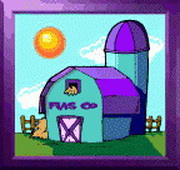Bloat
I have had people write me, concerned that their goat/kids were "bloating" when in fact they were fine. But, real bloat, if untreated, can cause death, so it is something to be aware of. I have only had a couple cases of bloat in my herd over many years. These cases were all cleared up with oil and massage.
Do you think your goat is fat?
You cannot tell fat from the belly. Goats are tricky because what looks fat to us is just a healthy goat. We call it "good condition". If you look at their belly, or width side to side, and this is really big or wide, that is not fat. That is good rumen development and a sign of a healthy goat. A goat's rumen is a big fermentation vat, and the bigger it is the better they process their food. A big rumen is a good thing.
CLICK HERE to read more regarding fat goats.
What is bloat?
When it isn't bloat:
What causes bloat?
|
|
Signs of bloat:
-
The abdomen is obviously distended, especially on the left side.
-
Signs of discomfort such as "mawing", kicking or grinding their teeth. Depression
-
In more serious forms: difficulty breathing.
Prevention:
-
Make sure to offer baking soda (sodium bicarbonate) free choice so the goats can regulate their rumens on their own. Baking soda aids in balancing the pH level in the rumen and helps to keep the digestive processes in tune.
-
Always make changes in diet gradual (especially with grain)
-
Restrict grazing time on rapidly growing rich pasture, or administer oil before turning them out on the pasture.
-
Don't turn out very hungry goats onto rich pasture; fill them up on hay first.
Treatment:
-
Stop the goat from eating any more.
-
Administer orally 1/4 - 1/3 cup of vegetable/peanut oil.
- The oil breaks the tension of the bubbles in the stomach/fermentation vat, so they can then pop and the gas expelled.
- Do not use mineral oil. Because mineral oil is tasteless, the goat may not know to swallow and the mineral oil could get into their lungs.
- Massage goats sides, especially the left side (rumen) until the goat begins to burp and fart.
-
If the bloat is really bad, call a vet immediately because the pressure in the abdomen can could stop the lungs and heart from working. The veterinarian will release the gas by making a small incision. The incision is made four fingers width behind the bottom of the ribs on the left side of the goat as it lies.
-
If the goat is near death, as a last resort, you may try puncturing the rumen with a stabbing action, using a very sharp, pointed knife or preferably a trocar and cannula. Aim for the highest spot on the left side and plunge into the rumen. The danger with this is that the rumen contents and/or dirt from the outside can get between the layers between the rumen, peritoneum and skin and cause a very serious infection called peritonitis. But if the goat in near death, anything is worth trying to save her.


